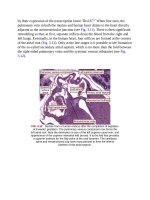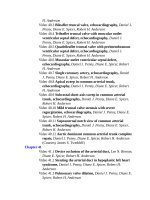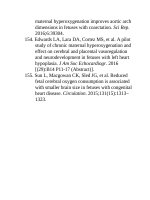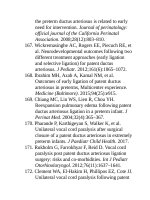Andersons pediatric cardiology 1148
Bạn đang xem bản rút gọn của tài liệu. Xem và tải ngay bản đầy đủ của tài liệu tại đây (198.86 KB, 3 trang )
cavityarewellformed.Thetricuspidvalveissimilarlywellformed.Right,
Thepulmonaryvalveisrepresentedbyanimperforateshelfinterposed
betweentheinfundibularcavityandthecavityofthepulmonarytrunk.
Intheseheartswithminimalmuralhypertrophy,theoutletcomponentis
patenttotheundersurfaceoftheimperforatepulmonaryvalve,whichseparates
therightventricularcavityfromthatofthepulmonarytrunk(seeFig.43.3,
right).Withincreasinghypertrophyofthewallsandobliterationoftheapical
componentoftheventricle,thecavityiseffectivelyformedbytheinletand
outletcomponents.Inthissituation,theinfundibulumstillextendstothe
undersurfaceoftheimperforatevalve,butthroughaverynarrowchannel.The
inletcomponentalsobecomeshypoplastic,withthetricuspidvalvetetheredby
shortcordstothemarginsoftheobliteratedapicalcomponent.Allthreeinitial
partsofthemorphologicallyrightventricleremainidentifiableintheheartswith
effectivelybipartiteventricularcavities.Thisremainsthecasewhenmural
hypertrophyhasalsosqueezedouttheoutletoftheventricle(Fig.43.4).
Individualshavingheartswiththecavityeffectivelyrepresentedbyonlythe
grosslyhypoplasticventricularinlet(Fig.43.5)representthemostseverely
incapacitatedpatientswithpulmonaryatresiaandintactventricularseptum.
FIG.43.4 Computedtomographicangiograminaneonatewithunipartite
pulmonaryatresiabasedonechocardiographicdata.The“squeezed-out”
apicalandoutletsegmentsareseenas“tongues”ofcontrastextending
towardtheapexandimperforatepulmonaryvalve,respectively.Inset,
Branchpulmonaryarteriesandductusfromabove.Thedatawereacquired
toshowmorphologyoftheductusarteriosustoassessthefeasibilityof
stenting.
FIG.43.5 Left,Theincreasingmuralhypertrophyhassqueezedoutthe
apicalandoutletventricularcomponents,leavingtheventricularcavity
representedonlybytheinlet.Inthissetting(right),thebaseofthe
pulmonarytrunkisrepresentedbythetriradiatingremnantsofthevalvar
sinuses,withnoremainingevidenceofthevalvarleaflets.
Whentheoutletcomponentisalsoobliterated,itisnotpossibletotracea
patentinfundibulumtotheventriculoarterialjunction,althoughevidenceofthe
channelinitiallypresentcanbeseenwithintheventricle(seeFig.43.5,left).
Whenexaminedfromthearterialaspect,itcanbeseenthatthepulmonarytrunk
retainsitsoriginfromtheRV(seeFig.43.5,right)sothattheventriculoarterial
connectionsremaineffectivelyconcordant.Theblind-endingpulmonarytrunk
originatesabovethetriradiatingsinuses,withthecentraldimpleindicatingthat
theydid,initially,supportvalvarleaflets.Thetricuspidvalveisgrossly
hypoplasticintheheartsinwhichthecavityoftheRVisrepresentedessentially
byonlytheinletcomponent,buttheleafletsthemselvesareusuallyminimally
malformed.Becauseofthis,thehypertrophiedmyocardiumisabletogenerate
suprasystemicventricularpressures.Heartsofthistypearetypicallyassociated
withabnormalitiesofthecoronaryarteries.Inthemostseverecases,the
proximalportionsofbothcoronaryarteriescanbeobliterated,withtheentirety
ofthecoronaryarterialtreefedthroughfistulouscommunicationsfromtheRV.41
Inlesssevereinstances,interruptionsarestillfoundintheoriginorcourseof
eithertherightortheleftcoronaryarteries(Fig.43.6).
FIG.43.6 Left,Magnificationofthebaseoftheheartinapatienthaving
aneffectivelyunipartiteventricularcavity.Therightcoronaryartery(RCA)
isatreticatitsoriginfromtheaorta.Theterritoryoftheanterior
interventriculararteryisfedprimarilyfromtherightventriclebytwo
prominentandectaticfistulouscommunications.Thepulmonarytrunkis
alsogrosslyhypoplastic.Right,Asecondheartwithafistulous
communicationagainfeedingtheanteriorinterventricularartery,whichis
ectatic.
Asignificantportionofthecoronaryarterialsupplyinsuchinstanceswill
againbeprovidedbyfistulouscommunicationsfromtheRV,underscoringthe
so-calledrightventricular–dependentcoronaryarterialcirculation,whichcreates
majorproblemsintreatment.2Thereforefistulouscommunicationsarethekeyto
diagnosisofthestateofthecoronaryarterialtree.Itisraretofindsuch
communicationsexceptwhenthereisgrossmuralhypertrophyandapoorly
formedcavity.Thismakesrecognitionofobliterationoftheinfundibuluman
importantdiagnosticfeaturewhenseekingtodeterminethebestoptionsfor
treatment.









